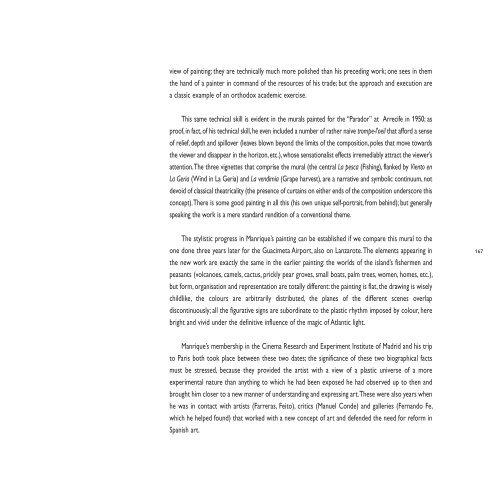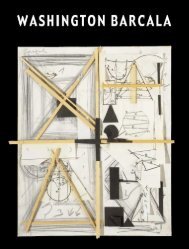VERSIÓN INGLESA ENGLISH VERSION - Fundación César Manrique
VERSIÓN INGLESA ENGLISH VERSION - Fundación César Manrique
VERSIÓN INGLESA ENGLISH VERSION - Fundación César Manrique
You also want an ePaper? Increase the reach of your titles
YUMPU automatically turns print PDFs into web optimized ePapers that Google loves.
view of painting; they are technically much more polished than his preceding work; one sees in them<br />
the hand of a painter in command of the resources of his trade; but the approach and execution are<br />
a classic example of an orthodox academic exercise.<br />
This same technical skill is evident in the murals painted for the “Parador” at Arrecife in 1950; as<br />
proof, in fact, of his technical skill, he even included a number of rather naive trompe-l’oeil that afford a sense<br />
of relief, depth and spillover (leaves blown beyond the limits of the composition, poles that move towards<br />
the viewer and disappear in the horizon, etc.), whose sensationalist effects irremediably attract the viewer’s<br />
attention. The three vignettes that comprise the mural (the central La pesca (Fishing), flanked by Viento en<br />
La Geria (Wind in La Geria) and La vendimia (Grape harvest), are a narrative and symbolic continuum, not<br />
devoid of classical theatricality (the presence of curtains on either ends of the composition underscore this<br />
concept). There is some good painting in all this (his own unique self-portrait, from behind); but generally<br />
speaking the work is a mere standard rendition of a conventional theme.<br />
The stylistic progress in <strong>Manrique</strong>’s painting can be established if we compare this mural to the<br />
one done three years later for the Guacimeta Airport, also on Lanzarote. The elements appearing in<br />
the new work are exactly the same in the earlier painting: the worlds of the island’s fishermen and<br />
peasants (volcanoes, camels, cactus, prickly pear groves, small boats, palm trees, women, homes, etc.),<br />
but form, organisation and representation are totally different: the painting is flat, the drawing is wisely<br />
childlike, the colours are arbitrarily distributed, the planes of the different scenes overlap<br />
discontinuously; all the figurative signs are subordinate to the plastic rhythm imposed by colour, here<br />
bright and vivid under the definitive influence of the magic of Atlantic light.<br />
<strong>Manrique</strong>’s membership in the Cinema Research and Experiment Institute of Madrid and his trip<br />
to Paris both took place between these two dates; the significance of these two biographical facts<br />
must be stressed, because they provided the artist with a view of a plastic universe of a more<br />
experimental nature than anything to which he had been exposed he had observed up to then and<br />
brought him closer to a new manner of understanding and expressing art. These were also years when<br />
he was in contact with artists (Farreras, Feito), critics (Manuel Conde) and galleries (Fernando Fe,<br />
which he helped found) that worked with a new concept of art and defended the need for reform in<br />
Spanish art.<br />
167
















![Becas y premios de la Fundación César Manrique [1997-2006]](https://img.yumpu.com/20766851/1/184x260/becas-y-premios-de-la-fundacion-cesar-manrique-1997-2006.jpg?quality=85)
